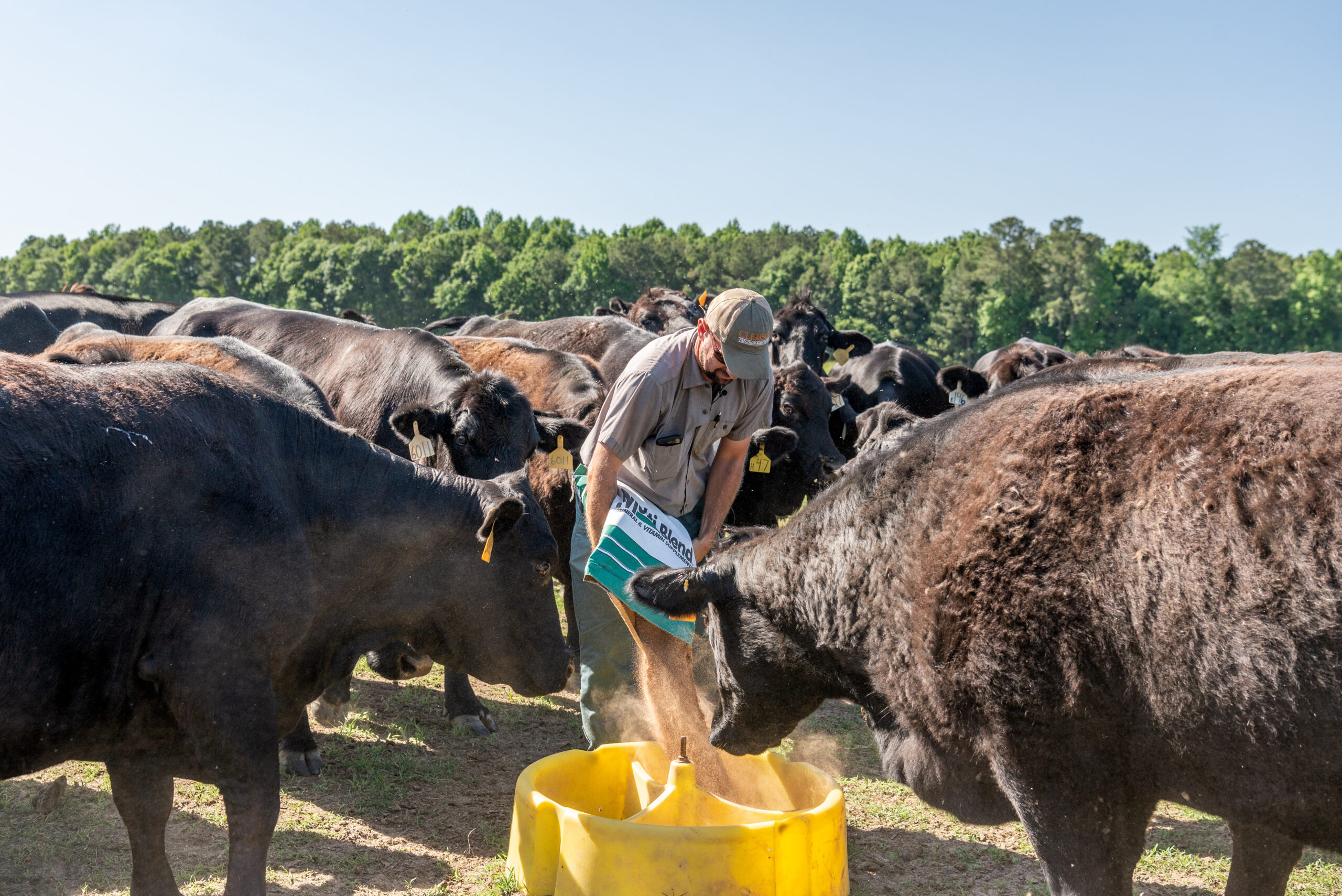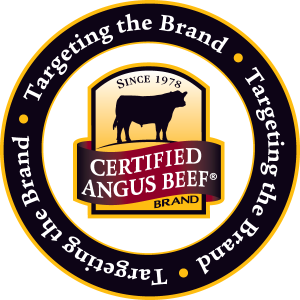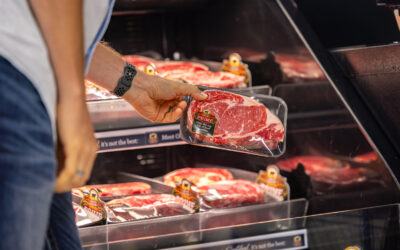
You, Your Cows and Their Feed
Build a nutritional management plan for good times and bad.
by Morgan Boecker & Lindsay Graber Runft, Certified Angus Beef
July 2023
A cowboy hat is just one that cattlemen wear – they’re also mechanics, accountants, conservationists, veterinarians, plumbers and nutritionists. But the area that often requires increased attention is nutrition, especially during a drought and when input costs, including feed resources, are high.
Today’s cow herd is the most efficient it’s ever been, but that doesn’t mean you can slack off in basic energy requirements when times get tough.
“It’s easy to just walk out there and say, ‘What can I cut?’ And in this environment, with the kind of production that we demand from these cattle and the money we spend on genetics, I think that’s a grave mistake,” said Dusty Abney, beef cattle nutritionist for Cargill Animal Nutrition.
There is no one size fits all approach to be sure you’re making the best decisions for your environment. But getting back to the basics of cattle management will assist you in doing more with less.
Finding the Right People
“There are some producers out there who are really good at nutrition, there are some folks that need a lot of help and there are people in between,” Abney said. “You’ve got to realize which you are and be honest with yourself and go ask for help when you need it.”
For Trew James, Lazy J Bar Cattle Company in Dalhart, Texas, he understood the kind of diet his commercial Angus cows and grow yard needed. He had worked with nutrition consultants in the past, but when he started seeing a lack in performance in his calves, he sought Abney for guidance.
“He saved my whole business through this drought,” James said. “The cattle just look good. Their hair is shiny and they’re growing more but eating less.”
Together they built a limit-feeding program so that extra feed isn’t being wasted while drought conditions have resources scarce. Now, James can feed less roughage with the right amount of minerals for his cow herd and calves on feed and still see significant gains. He sees fewer open cows after breeding. Weaned calves are healthier and heavier and go on to gain half a pound more than normal with no extra feed, he added.
“I save money on feed rations but invest in minerals,” James said. “But because the calves grow better, I make more money.”
It starts by asking for help – ask until you find the right partner. James suggested inquiring if feed suppliers have consultants on staff. Other resources may be your state extension agents or independent nutrition consultants who understand your current climate. There are a lot of things you can learn from industry publications and educational events, but the most important thing is to find someone who knows your environment and what you’re up against.
“It’s an investment in the future of your operation,” Abney said. “Because if you make wasteful decisions and those decisions come back to haunt you, it’s not going to be in a time when prices are good.”

Plan for the Good and Bad
When managing your resources is complicated by conditions outside of our control, sharper management can still find the rewards in ranching. By managing what can be managed and considering potential outcomes (good or bad), you can target positive results.
“We have to make sure that we’re not giving into analysis paralysis where we just wait for something else to happen,” Abney said. “Not making a decision is still a decision.”
Take a harder look at things you can control, such as feed waste. Abney said well-run operations can suffer from 5-10% feed waste daily, depending on the type of ingredient and how it is fed, such as delivery and feeder type.
A 2015 University of Missouri study into fescue hay waste by bale feeder type found a 19.2% loss for open rings, 13.6% for those with a bottom sheet and 8.9% for cone designs.
Correct hay storage helps reduce waste, too, Abney said. Ensiled forages are susceptible to loss from poor fermentation or exposure to air after fermentation.
Meeting Essential Nutrients
“Doing what you have to” in times of high operating costs makes sense, Abney said. Fetal programming implications say nutritional decisions on bred females affect a cow herd in the short and long term.
“If you short her, she will short you,” Abney said. “A cow never gets a day off, and what we provide that animal from a supplementary basis and from our forage base affects her and her calf.”
What and how you feed a cow matters. Consider ingredient sourcing, infrastructure and the balance of nutrients against requirements. Then look at the feeding process: quantity, time and method for feeding. Nutritionists can provide key advice on the “what and how” to achieve targeted gains, improved herd health and overall profitability.
Looking to a drought scenario specifically, Abney noted the first step of understanding what’s available for cows to consume. To keep rumens operational, cows need more than 1% roughage on a dry-matter basis. Supplement that with energy, such as corn, distiller’s grains or whole cottonseed, based on nutritional requirements.
High-quality beef production requires mineral supplementation. But through a drought, that supplement can vary greatly. Forage test results and other feed evaluations can show where to adjust mineral inputs for a better bottom line.
“Working with Dusty helped me understand that cows don’t need a lot extra,” James said. “The right combination of roughage and mineral will let them do more with less. And when it starts raining again, I’ll definitely talk to him about the best mineral package.”
Nutrition and feed resource management, along with all profit areas of an operation, deserve time and careful attention throughout the cattle market cycle. Without a proactive plan in place, a greater impact could be felt for years to come.

Maximize Genetics (sidebar)
From a bull purchased during this bull sale season, to calves born and heifers retained this year, the nutrition plan for those animals determines if they’ll perform as anticipated.
“If you invest in genetics and don’t invest in your nutritional program, your animals will never express their full genetic potential,” Abney said.
Even with increasing prices at the meat case, consumers continue to purchase high-quality beef. That’s why Abney cautioned against decreasing the bull budget. Investments in superior genetics could still pay.

Targeting the Brand translates to Angus feeder calves enrolled in the AngusLink℠ Genetic Merit Scorecard. Groups of enrolled calves that are predominantly black and have a 125 Grid Score or higher are eligible to use the logo, too.
You may also like
CAB Sets Sales Records, Sees Historically High Brand Acceptance Rates
In an otherwise tough time in the beef business, sales and supply records have been a bright spot. The positive numbers mean that quality beef production has not let up, and beef demand is holding. Consumers have proven the value proposition: the good stuff is worth a little more money, for a better eating experience.
Feeding Quality Forum Dates Set Earlier in August
When you’re feeding cattle, it counts to keep track of every calf, pound and dollar. Beyond the event’s educational sessions, networking between segments of the beef supply chain is invaluable—from feeders and cow-calf operators to allied industry and university researchers.
Gardiners Highlight Service, Strength at Foodservice Leaders Summit
Mark Gardiner and his son, Cole, of Gardiner Angus Ranch offered a boots-on-the-ground perspective for CAB specialists attending the annual event, designed to deliver resources that help train foodservice teams and serve consumers at a higher level.



